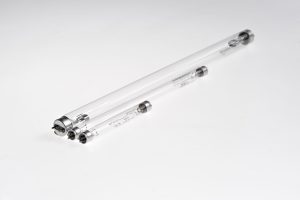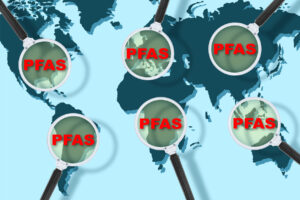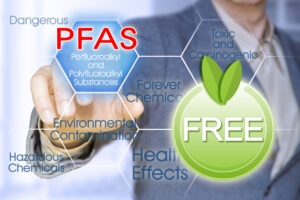UV Light in the Fight Against Forever Chemicals: A Closer Look at PFAS Destruction
Ultraviolet light, a longstanding tool in the battle against microbial pathogens, now shows promising potential in the fight against one of today’s most daunting environmental challenges: PFAS contamination.
As regulatory pressures mount and public awareness of the risks associated with these persistent chemicals grows, the quest for effective remediation strategies has become more urgent. Advances in UV technology, particularly through innovative applications of advanced oxidation processes, offer a glimmer of hope for breaking down these so-called “forever chemicals,” transforming them from persistent pollutants into manageable compounds.
Definition and History of PFAS
Perfluoroalkyl and polyfluoroalkyl substances (PFAS) are synthetic chemicals that include over 4,700 individual compounds known for their strong carbon-fluorine bonds, which confer exceptional resistance to heat, water, and oil. Originally developed in the 1930s, PFAS found their first significant application in the manufacturing of firefighting foams during World War II due to their ability to smother intense fires quickly. By the 1950s, these chemicals had proliferated into various consumer products, including Teflon coatings, fabric protectants, and food packaging, due to their unique non-stick and water-repellent properties.
Over the decades, as their use expanded globally, so did the recognition of their persistence in the environment, leading to growing scrutiny and concern in recent years.
The Persistence of PFAS: Environmental and Health Impacts
Perfluoroalkyl and polyfluoroalkyl substances (PFAS) are a group of man-made chemicals that have earned the nickname “forever chemicals” due to their inability to degrade in the natural environment. The chemical stability that makes PFAS so useful in products also causes them to accumulate in the environment and the human body, leading to significant health risks including cancer, immune system disruption, and hormonal imbalances.
Common Sources and Locations of PFAS Contamination
PFAS contamination can be found almost everywhere—ranging from water to soil to living organisms. Major sources include industrial sites where PFAS are used or manufactured, areas using aqueous film-forming foams (AFFFs) such as airports and military bases, and landfills where products containing PFAS end up. These chemicals can leach into drinking water supplies, contaminate soil, or become airborne as dust.
PFAS are not just a problem in isolated areas; they have been detected in the Arctic ice and deep-ocean trenches, indicating their extensive reach and distribution across the globe.
Health and Environmental Risks Associated with PFAS
The health and environmental risks linked to PFAS exposure are profound and concerning. On the human health front, PFAS have been associated with several serious conditions, including cancer (particularly kidney and testicular cancers), liver damage, immune system disruptions, and developmental delays in children.
Environmentally, PFAS accumulate in wildlife, leading to toxicity that can affect entire ecosystems. These chemicals do not break down naturally, contributing to their “forever chemicals” nickname, and instead accumulate over time, making their environmental impact long-lasting and difficult to reverse.
This broad distribution, combined with their significant durability, makes PFAS a complex and pressing issue in environmental science and public health, necessitating innovative and effective solutions for their management and remediation.
Global Response to a Growing Crisis
As the widespread presence of PFAS in water supplies, soil, and even the food chain becomes more apparent, international regulatory bodies and environmental agencies are intensifying their focus on these compounds. The need for effective PFAS regulation and remediation techniques has never been more urgent, as these substances pose a persistent challenge to environmental safety and public health.
The Challenge of PFAS to the Water Industry
Detecting and Removing PFAS from Water Supplies
The pervasive nature of PFAS presents unique challenges to the water industry, particularly in the areas of detection and removal. These chemicals are not only exceptionally resistant to breakdown but also soluble in water, making them difficult to manage and eliminate from water supplies. Traditional water treatment processes, such as carbon filtration and reverse osmosis, require extensive modifications or are insufficient on their own to fully remove PFAS compounds.
The difficulty is compounded by the fact that PFAS can exist in very low concentrations, yet still pose significant health risks. Advanced detection methods are thus necessary to trace these minute quantities, involving sophisticated equipment and technical expertise that can strain local water treatment facilities’ capabilities and budgets.
Current Standards and Regulations
Regulatory standards for PFAS in drinking water vary widely across different regions and are continually evolving as new research comes to light about their health impacts. In the United States, the Environmental Protection Agency (EPA) has issued health advisories for two of the most studied PFAS compounds, PFOA and PFOS, setting non-enforceable limits at 70 parts per trillion combined. However, many advocates and scientists argue that even lower levels may be necessary to protect public health, prompting some states to establish their own stricter guidelines.
Internationally, the European Union has been proactive, proposing a drinking water limit of 0.1 micrograms per liter for two PFAS compounds and a combined limit of 0.5 micrograms per liter for all PFAS substances detected. These regulations are part of a broader initiative to phase out the use of PFAS where safer alternatives exist and to clean up contaminated sites.
The challenge is not only regulatory but also technical, as the water industry must adapt to these stringent standards. The recent updates from global authorities reflect a growing recognition of the need for aggressive measures to manage PFAS contamination, pushing for innovations in water treatment technologies and stronger enforcement of pollution controls.
As the regulations surrounding PFAS continue to tighten and the scientific community’s understanding of these compounds deepens, the water industry faces increasing pressure to implement effective solutions that can address both current contamination and prevent future occurrences. This necessitates a commitment to research and development in water treatment technologies, including potentially promising solutions like UV advanced oxidation processes, which could play a significant role in degrading PFAS compounds that traditional methods struggle to address.
First-Ever National Drinking Water Standard
In a significant move to combat PFAS contamination, the Biden-Harris administration finalized the first-ever National Drinking Water Standard in April of 2024, supported by a substantial financial commitment through the Bipartisan Infrastructure Law. The Environmental Protection Agency (EPA) is set to distribute nearly $1 billion in funds to assist states and territories in implementing PFAS testing and treatment initiatives for public water systems and aiding private well owners. Learn more about PFAS Drinking Water Regulation and Treatment Methods.
This funding is part of a broader $9 billion allocation aimed specifically at addressing drinking water systems affected by PFAS and other emerging contaminants. This initiative represents the largest investment ever committed to the mitigation of PFAS pollution. Additionally, an extra $12 billion has been allocated for general drinking water improvements, which include measures to tackle emerging contaminants like PFAS, underlining a historic commitment to enhancing water quality and public health safeguards across the United States.
Advances in UV Technology for PFAS Destruction
 Ultraviolet (UV) technology, particularly through the deployment of medium-pressure and low-pressure UV lamps producing 185nm light, plays a pivotal role in the advanced oxidation processes (AOPs) crucial for breaking down PFAS. This specific wavelength is highly effective at generating hydroxyl radicals when UV light interacts with water. Hydroxyl radicals are extremely reactive and capable of breaking down PFAS compounds into less harmful substances, offering a promising avenue for environmental remediation.
Ultraviolet (UV) technology, particularly through the deployment of medium-pressure and low-pressure UV lamps producing 185nm light, plays a pivotal role in the advanced oxidation processes (AOPs) crucial for breaking down PFAS. This specific wavelength is highly effective at generating hydroxyl radicals when UV light interacts with water. Hydroxyl radicals are extremely reactive and capable of breaking down PFAS compounds into less harmful substances, offering a promising avenue for environmental remediation.
Medium pressure UV lamps are valued for their broad-spectrum output and high-intensity UV light, covering a wide range of wavelengths, including 185nm. This broad spectrum enables them to initiate multiple photolytic and photocatalytic reactions, which are crucial for decomposing complex organic molecules like PFAS. For instance, a study published in the Journal of Hazardous Materials highlights that “PFAS can be effectively degraded through hydroxyl radicals produced during UV irradiation” (ScienceDirect, 2023). This process underscores the potential of medium pressure lamps in environmental applications,
Low pressure UV lamps, which typically emit at a narrower range of wavelengths, are highly efficient at producing light at the 185nm wavelength. This precision targets specific reactions necessary for the effective treatment of contaminated water. Research supports that low-pressure UV lamps are particularly effective in environments where targeted photolysis is required, contributing to significant reductions in PFAS concentrations (PubMed, 2007).
The strategic deployment of these UV lamps in water treatment processes not only enhances the degradation of PFAS but also ensures that the treatment remains energy-efficient and cost-effective. This combination of efficacy and economy makes UV technology a crucial component of modern water treatment infrastructures, capable of addressing some of the most persistent and challenging pollutants in our environment.
Exploring these advances is essential for understanding how UV treatment can be integrated into strategies aimed at mitigating the environmental impact of PFAS.
LightSources offers high-tech, innovative UV solutions custom-engineered to meet complex environmental challenges. LightSources lighting engineers possess deep technical knowledge of UV radiation to custom engineer lamp design including phosphor blends and custom bases, to optimize lamp output. We offer low-pressure and medium-pressure UV lamps designed for optimal output in the 185 nanometers (nm) range which is shown to play a significant role in degrading PFAS compounds.
Resources:
Environmental Protection Agency, (2024), Per- and Polyfluoroalkyl Substances (PFAS), https://www.epa.gov/pfas
European Environment Agency, (2024), Treatment of drinking water to remove PFAS (Signal), https://www.eea.europa.eu/en/european-zero-pollution-dashboards/indicators/treatment-of-drinking-water-to-remove-pfas-signal
Environmental Protection Agency, (2024), Biden-Harris Administration Finalizes First-Ever National Drinking Water Standard to Protect 100M People from PFAS Pollution, https://www.epa.gov/newsreleases/biden-harris-administration-finalizes-first-ever-national-drinking-water-standard
Environmental Protection Agency, (2024), PFAS Drinking Water Regulation and Treatment Methods, https://www.epa.gov/system/files/documents/2024-05/epa-sdws-pfas-regtrmt-webinar_slides_april-30-2024.p
Science Direct (2023, July), Validation of UV/persulfate as a PFAS treatment of industrial wastewater and environmental samples, https://www.sciencedirect.com/science/article/pii/S2214714423001319#:~:text=PFAS%20can%20be%20effectively%20degraded,O8%20and%204%20h
National Institute of Health, (2007), Photodegradation of perfluorooctanoic acid by 185 nm vacuum ultraviolet light, https://pubmed.ncbi.nlm.nih.gov/17915698/







